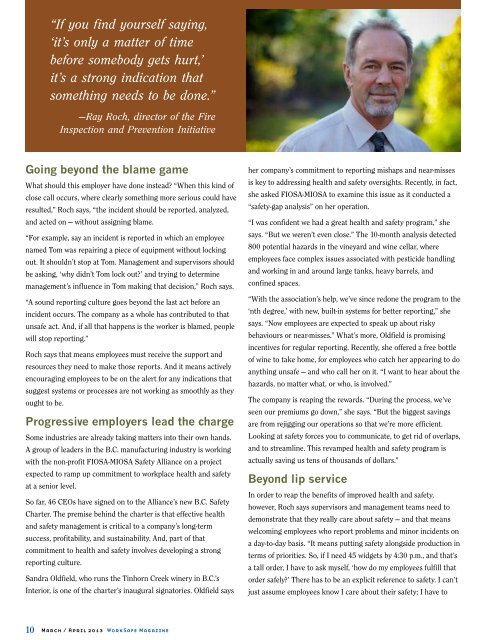Fair warning
Fair warning
Fair warning
You also want an ePaper? Increase the reach of your titles
YUMPU automatically turns print PDFs into web optimized ePapers that Google loves.
Going beyond the blame game<br />
What should this employer have done instead? “When this kind of<br />
close call occurs, where clearly something more serious could have<br />
resulted,” Roch says, “the incident should be reported, analyzed,<br />
and acted on — without assigning blame.<br />
“For example, say an incident is reported in which an employee<br />
named Tom was repairing a piece of equipment without locking<br />
out. It shouldn’t stop at Tom. Management and supervisors should<br />
be asking, ‘why didn’t Tom lock out?’ and trying to determine<br />
management’s influence in Tom making that decision,” Roch says.<br />
“A sound reporting culture goes beyond the last act before an<br />
incident occurs. The company as a whole has contributed to that<br />
unsafe act. And, if all that happens is the worker is blamed, people<br />
will stop reporting.”<br />
Roch says that means employees must receive the support and<br />
resources they need to make those reports. And it means actively<br />
encouraging employees to be on the alert for any indications that<br />
suggest systems or processes are not working as smoothly as they<br />
ought to be.<br />
Progressive employers lead the charge<br />
Some industries are already taking matters into their own hands.<br />
A group of leaders in the B.C. manufacturing industry is working<br />
with the non-profit FIOSA-MIOSA Safety Alliance on a project<br />
expected to ramp up commitment to workplace health and safety<br />
at a senior level.<br />
So far, 46 CEOs have signed on to the Alliance’s new B.C. Safety<br />
Charter. The premise behind the charter is that effective health<br />
and safety management is critical to a company’s long-term<br />
success, profitability, and sustainability. And, part of that<br />
commitment to health and safety involves developing a strong<br />
reporting culture.<br />
Sandra Oldfield, who runs the Tinhorn Creek winery in B.C.’s<br />
Interior, is one of the charter’s inaugural signatories. Oldfield says<br />
10<br />
“If you find yourself saying,<br />
‘it’s only a matter of time<br />
before somebody gets hurt,’<br />
it’s a strong indication that<br />
something needs to be done.”<br />
—Ray Roch, director of the Fire<br />
Inspection and Prevention Initiative<br />
March / April 2013 WorkSafe Magazine<br />
her company’s commitment to reporting mishaps and near-misses<br />
is key to addressing health and safety oversights. Recently, in fact,<br />
she asked FIOSA-MIOSA to examine this issue as it conducted a<br />
“safety-gap analysis” on her operation.<br />
“I was confident we had a great health and safety program,” she<br />
says. “But we weren’t even close.” The 10-month analysis detected<br />
800 potential hazards in the vineyard and wine cellar, where<br />
employees face complex issues associated with pesticide handling<br />
and working in and around large tanks, heavy barrels, and<br />
confined spaces.<br />
“With the association’s help, we’ve since redone the program to the<br />
‘nth degree,’ with new, built-in systems for better reporting,” she<br />
says. “Now employees are expected to speak up about risky<br />
behaviours or near-misses.” What’s more, Oldfield is promising<br />
incentives for regular reporting. Recently, she offered a free bottle<br />
of wine to take home, for employees who catch her appearing to do<br />
anything unsafe — and who call her on it. “I want to hear about the<br />
hazards, no matter what, or who, is involved.”<br />
The company is reaping the rewards. “During the process, we’ve<br />
seen our premiums go down,” she says. “But the biggest savings<br />
are from rejigging our operations so that we’re more efficient.<br />
Looking at safety forces you to communicate, to get rid of overlaps,<br />
and to streamline. This revamped health and safety program is<br />
actually saving us tens of thousands of dollars.”<br />
Beyond lip service<br />
In order to reap the benefits of improved health and safety,<br />
however, Roch says supervisors and management teams need to<br />
demonstrate that they really care about safety — and that means<br />
welcoming employees who report problems and minor incidents on<br />
a day-to-day basis. “It means putting safety alongside production in<br />
terms of priorities. So, if I need 45 widgets by 4:30 p.m., and that’s<br />
a tall order, I have to ask myself, ‘how do my employees fulfill that<br />
order safely?’ There has to be an explicit reference to safety. I can’t<br />
just assume employees know I care about their safety; I have to


